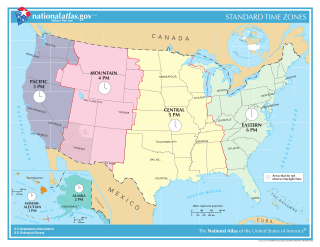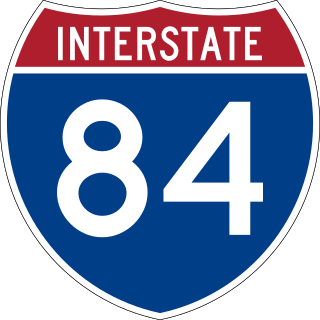
A time zone is an area which observes a uniform standard time for legal, commercial and social purposes. Time zones tend to follow the boundaries between countries and their subdivisions instead of strictly following longitude, because it is convenient for areas in frequent communication to keep the same time.

The history of standard time in the United States began November 18, 1883, when United States and Canadian railroads instituted standard time in time zones. Before then, time of day was a local matter, and most cities and towns used some form of local solar time, maintained by some well-known clock. The new standard time system was not immediately embraced by all.

The Eastern Time Zone (ET) is a time zone encompassing part or all of 23 states in the eastern part of the United States, parts of eastern Canada, and the state of Quintana Roo in Mexico.

The Alaska Time Zone observes standard time by subtracting nine hours from Coordinated Universal Time (UTC−09:00). During daylight saving time its time offset is eight hours (UTC−08:00). The clock time in this zone is based on mean solar time at the 135th meridian west of the Greenwich Observatory.

In the United States, time is divided into nine standard time zones covering the states, territories and other US possessions, with most of the country observing daylight saving time (DST) for approximately the spring, summer, and fall months. The time zone boundaries and DST observance are regulated by the Department of Transportation, but no single map of those existed until the agency announced intentions to make one in September 2022. Official and highly precise timekeeping services (clocks) are provided by two federal agencies: the National Institute of Standards and Technology (NIST) ; and the United States Naval Observatory (USNO). The clocks run by these services are kept synchronized with each other as well as with those of other international timekeeping organizations.

The Atlantic Time Zone is a geographical region that keeps standard time—called Atlantic Standard Time (AST)—by subtracting four hours from Coordinated Universal Time (UTC), resulting in UTC−04:00. AST is observed in parts of North America and some Caribbean islands. During part of the year, some portions of the zone observe daylight saving time, referred to as Atlantic Daylight Time (ADT), by moving their clocks forward one hour to UTC−03:00. The clock time in this zone is based on the mean solar time of the 60th meridian west of the Greenwich Observatory.

UTC−04:00 is an identifier for a time offset from UTC of −04:00.

The tz database is a collaborative compilation of information about the world's time zones, primarily intended for use with computer programs and operating systems. Paul Eggert has been its editor and maintainer since 2005, with the organizational backing of ICANN. The tz database is also known as tzdata, the zoneinfo database or the IANA time zone database, and occasionally as the Olson database, referring to the founding contributor, Arthur David Olson.

Interstate 84 (I-84) in Massachusetts is the easternmost segment of the eastern I-84 freeway originating in Dunmore, Pennsylvania,. Within Massachusetts, I-84 exists in the towns of Holland and Sturbridge. Known as the Wilbur Cross Highway, it has also been signed as Route 15 between 1948 and 1980 as well as Interstate 86 (I-86) between 1971 and 1984. The Massachusetts segment of I-84 is the shortest state length of the four states it travels through.

The U.S. state of Indiana is divided into Eastern and Central time zones. The official dividing line has generally moved progressively west from its original location on the Indiana–Ohio border, to a position dividing Indiana down the middle, and finally to its current location along much of the Indiana–Illinois border. In April 2006, several southwestern and northwestern counties reverted to Central time.

Most of the United States observes daylight saving time, the practice of setting the clock forward by one hour when there is longer daylight during the day, so that evenings have more daylight and mornings have less. Exceptions include Arizona, Hawaii, and the overseas territories of American Samoa, Guam, the Northern Mariana Islands, Puerto Rico, and the United States Virgin Islands. The Uniform Time Act of 1966 established the system of uniform daylight saving time throughout the US.

Europe spans seven primary time zones, excluding summer time offsets. Most European countries use summer time and harmonise their summer time adjustments; see Summer time in Europe for details.
Hawaii is in the Hawaii–Aleutian Time Zone and does not observe daylight saving time.

Time in Arizona, as in all U.S. states, is regulated by the United States Department of Transportation as well as by state and tribal law.

Time in Maine, as in all US states, is regulated by the United States Department of Transportation. All of Maine is in the Eastern Time Zone (ET) and observes daylight saving time (DST).

Time in Massachusetts, as in all US states, is regulated by the United States Department of Transportation. Massachusetts is in the Eastern Time Zone (ET) and observes daylight saving time (DST).

Time in New Hampshire, as in all US states, is regulated by the United States Department of Transportation. New Hampshire is in the Eastern Time Zone (ET) and observes daylight saving time (DST).

Time in Rhode Island, as in all US states, is regulated by the United States Department of Transportation. Rhode Island is in the Eastern Time Zone (ET) and observes daylight saving time (DST).

Time in Vermont, as in all US states, is regulated by the United States Department of Transportation. Vermont is in the Eastern Time Zone (ET) and observes daylight saving time (DST).

Iceland observes UTC±00:00 year-round, known as Greenwich Mean Time or Western European Time. UTC±00:00 was adopted on 7 April 1968 – in order for Iceland to be in sync with Europe – replacing UTC−01:00, which had been the standard time zone since 16 November 1907. Iceland previously observed daylight saving time, moving the clock forward one hour, between 1917 and 1921, and 1939 and 1968. The start and end dates varied, as decided by the government. Between 1941 and 1946, daylight saving time commenced on the first Sunday in March and ended in late October, and between 1947 and 1967 it commenced on the first Sunday in April, in all instances since 1941 occurring and ending at 02:00. Since 1994, there have been an increasing number of proposals made to the Althing to reintroduce daylight saving time for a variety of reasons, but all such proposals and resolutions have been rejected.












